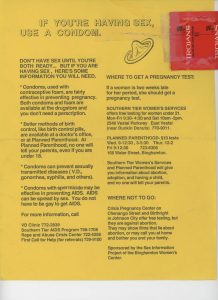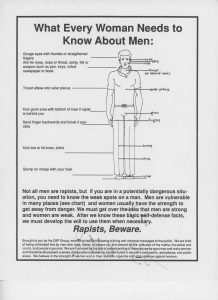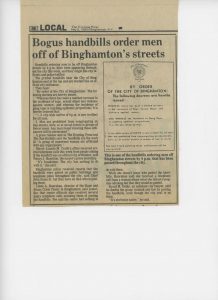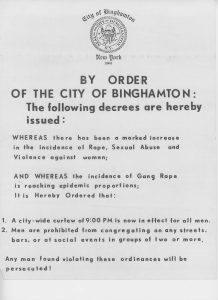 The Binghamton Women’s Center was founded in 1973 and exists to the present in the form of the Center for Gender, Art, and Culture. In its earliest iteration, the Women’s Center was a multi issue organization with community meetings and a loose committee structure to address issues such as sexual assault, abortion, divorce and displaced homemakers, lesbian rights, domestic violence and child abuse, women’s health, poverty and housing issues, etc. For several years the Women’s Center ran an information and referral service to offer women callers referrals to a variety of services, including sympathetic lawyers, health professionals, abortion providers; staff were paid by Opportunities for Broome through the CETA (Comprehensive Employment and Training Act) program.
The Binghamton Women’s Center was founded in 1973 and exists to the present in the form of the Center for Gender, Art, and Culture. In its earliest iteration, the Women’s Center was a multi issue organization with community meetings and a loose committee structure to address issues such as sexual assault, abortion, divorce and displaced homemakers, lesbian rights, domestic violence and child abuse, women’s health, poverty and housing issues, etc. For several years the Women’s Center ran an information and referral service to offer women callers referrals to a variety of services, including sympathetic lawyers, health professionals, abortion providers; staff were paid by Opportunities for Broome through the CETA (Comprehensive Employment and Training Act) program.
An important issue that emerged was the incidence of sexual assault and abuse and a committee  focused on activism on this issue, particularly demanding that police and prosecutor’s office pursue cases against rapists and abusers. Their efforts in 1977 resulted in the formation of the Rape Crisis Center (later the Rape and Abuse Crisis Center and now the Crime Victim Assistance Center). The RCC established the first 24 hour volunteer hotline which has been answered continuously by trained counselors for the past 40 years. The SOS Shelter, which was opened a few years later benefited from the Women’s Center and Rape Crisis Center’s public education and participation. On May 3, 1988 a large Take Back the Night march demanded the “elimination of violence against women.” Another one was called for October 29, 1992.
focused on activism on this issue, particularly demanding that police and prosecutor’s office pursue cases against rapists and abusers. Their efforts in 1977 resulted in the formation of the Rape Crisis Center (later the Rape and Abuse Crisis Center and now the Crime Victim Assistance Center). The RCC established the first 24 hour volunteer hotline which has been answered continuously by trained counselors for the past 40 years. The SOS Shelter, which was opened a few years later benefited from the Women’s Center and Rape Crisis Center’s public education and participation. On May 3, 1988 a large Take Back the Night march demanded the “elimination of violence against women.” Another one was called for October 29, 1992.
Another active committee gave a presence and voice to lesbians; the Lesbian Switchboard was established in 1978 to provide a contact point and referrals to services. Herizon, a women’s social club, founded in 1975 and enduring until 1991, was another outgrowth of lesbian organizing through the Women’s Center.
Starting in 1980 or 1981, the Women’s Center’s newsletter became
For over a decade the Women’s Center raised money in a one day event every August called the WonderWoman Festival. It included local entertainment, a rowdy auction of goods and services, food, and other events and fundraisers. “WonderWoman” was a focal point for the community, particularly allowing lesbians to be visible and participate.


In 1989, the Women’s Center participated in a collaborative effort called the SPACE (“The Space for Political And Cultural Expressions”) with other groups including Carousel Arts Collective, Herizon, Women’s Center, SYOL (Save Your Own Life), Inesse: Emerging Women Artists, People Living with AIDS, KUUMBA. This was a way of keeping a space with several groups collaborating but it was not successful.

This paper was given at a conference on local history at the Bundy Museum and History Center in March 2018. It was recorded and is available online on their site.
–Peg Johnston, 1/2018
www.binghamtonbridge.org binghamtonbridge@gmail.com or deptofpublicart@gmail.com
